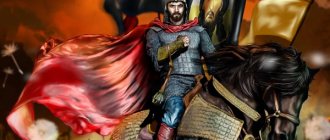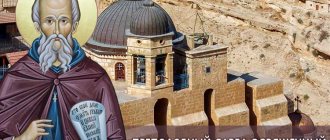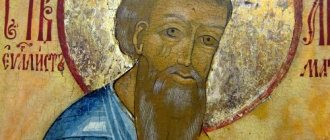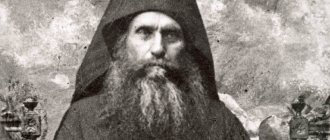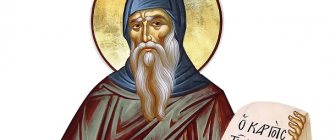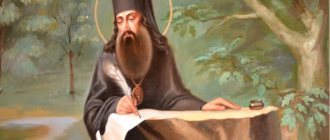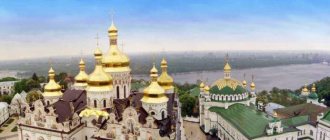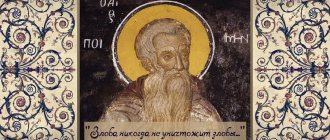According to historical information, the Monk Isaac was born in Syria, but we know almost nothing about the childhood and youth of the Christian ascetic. The Saint himself repeatedly said that his life before the beginning of the hermit’s path was of little importance for his followers, because the main work of the life of Isaac of Dalmatia was serving the Lord.
Many historical testimonies have reached us about the hermit period in the life of the righteous man - thanks to Christian deeds and true piety, Saint Isaac was able to glorify his name for centuries.
Life of Isaac of Dalmatia
Saint Isaac led a hermit's life and spent several decades in the desert before he heard a voice from above commanding him to go to Constantinople. At that time, the capital of Byzantium was engulfed in heretical teachings, the supporters of which were the current emperor Valens.
Venerable Isaac of Dalmatia
Saint Isaac repeatedly asked Valens to renounce false teaching and stop persecuting Orthodox Christians, but the ruler did not want to hear any arguments from the righteous man. He ordered his soldiers to beat Isaac and throw him into the swamp, from which not a single person had previously been able to escape.
However, the ruler did not foresee that the angels would save the righteous man from the fetid mud, and he would again appear before the emperor, without abandoning his intentions to protect Christians from the arbitrariness of the authorities. Then Valens ordered the Saint to be thrown into prison, promising Isaac to deal with him upon his return from the military campaign.
The saint told the ruler that their meeting was not destined to take place, and predicted a terrible death for Valens. This actually happened - the emperor’s army was defeated by the enemy, and the escaped ruler was burned alive in the barn in which he wanted to hide from his pursuers.
Theodosius the Great became the heir to the throne. Immediately after ascending to the throne, he ordered the release of Saint Isaac from prison and received him in the palace with all honors. After participating in the Second Ecumenical Council, the Saint wanted to go to his cell and continue living in the desert, but his disciples begged him not to do this and to remain in Constantinople.
Interesting! Sometimes Isaac himself visited those people who, due to poor health, could not come to him themselves. Repeatedly, the monarch Theodosius invited the righteous man to his palace, where he greeted him with constant honors.
A secluded cell was built for the Saint so that he could spend enough time in prayer, completely devoting himself to communication with God. Despite the fact that the Saint’s cell was located outside the city, many people constantly came there. Ordinary residents of Constantinople came to the Saint every day for advice and instructions, and Saint Isaac did not refuse anyone.
The main work of the life of Isaac of Dalmatia was serving the Lord
Soon, a monastery was erected on the spot where the monk’s cell was originally built. Isaac of Dalmatia lived in it until his death. The saint foresaw the imminent approach of death, so he chose a successor from among his disciples in advance. Immediately after this, the Saint quietly departed to the Lord.
Theodosius the Great was greatly upset by the death of the ascetic and ordered Isaac of Dalmatia to be buried in the Cathedral of Constantinople with great honors. However, Isaac's disciples and simple monks of the monastery knew that the primate was a modest man who did not want pompous celebrations. They begged the ruler to bury the Saint in a church located not far from the monastery in which the righteous man lived. So Isaac of Dalmatia was buried in the altar of the Church of St. Stephen.
Venerable Isaac of Dalmatia, abbot
The Monk Isaac came “from the east,” most likely from Syria. He labored in the desert until he heard a voice from heaven commanding him to go to Constantinople. Arriving there, the saint found the capital engulfed in the Arian heresy, of which Emperor Valens (364–378) was an adherent. When the emperor was preparing to go to war with the barbarians[1], St. Isaac approached him several times with exhortations, asking him to open the churches and stop the persecution of the Orthodox. For this, the emperor's entourage beat the saint, and Valens ordered him to be thrown into a fetid swamp, from which not a single creature emerged alive. But 2 angels miraculously delivered St. Isaac from death. Coming to the emperor for the last time, he predicted his defeat in the war and death in fire. The angry emperor ordered the ascetic to be thrown into prison until his return. According to the saint's prophecy, Valens' army was defeated by the barbarians, and the emperor, fleeing for his life, burned in a wooden barn set on fire by his pursuers.
About the meeting of Rev. Isaac and Valens and the prediction of the defeat and death of the emperor are also reported by church historians. Theodoret of Cyrus[2], Sozomen[3] and some others. In the synaxarical Life of St. Isaac[4] in connection with these events, a story is given that is not found in other editions: the saint learned about the death of the emperor even before the news reached Constantinople, for he miraculously smelled the smell of a burnt body coming from the battlefield[5]. This story was subsequently retold by the historian John Zonara[6].
After the death of Emperor Valens, Emperor Theodosius I the Great (379–395) ascended the throne. Hearing about the saint’s prophecy, the emperor ordered his release from prison and received him with honor in the palace. After this, Rev. Isaac, according to the Life, participated in the Second Ecumenical Council (381) (however, he is not noted in the lists of participants in the Council). Then the saint wanted to return to the desert, but the pious nobles Saturninus and Victor asked him not to leave Constantinople and not to abandon their spiritual children. Having heeded their persuasion, St. Isaac asked to build a cell for him. Each of the nobles built a dwelling for him on his estate, and the saint chose a modest cell built by Saturninus. It was located in the suburbs of Constantinople, outside the city walls. Many people from the city came to the saint; he visited the residents at their requests in order to pray with them and bless their homes. Emperor Theodosius also repeatedly invited him to the palace. St. Isaac always sought to help the poor, and if someone met him on the road and asked for alms, he would take off his cloak and give it to a beggar. If he returned from the city and the gates were already closed, then after the saint’s prayer and sign of the cross they always miraculously opened. After some time, a monastery was founded around Isaac’s cell, later called Dalmata Monastery, which was considered the oldest in Constantinople[7]; The saint lived there until the end of his days.
Feeling the approach of death, St. Isaac convened his disciples, instructed them in the right faith, and chose one among them, named Dalmatus, whom he appointed as his successor.
After the death of the saint, the emperor ordered a solemn burial with a procession to the church of St. Irene (which was then the cathedral of Constantinople). The brethren of the monastery and the disciples of the saint asked permission to place the remains of Isaac in the church of St. Stephen, built near the Dalmatian monastery. St. Isaac was buried in the altar of this temple, to the right of the holy altar.
Based on the text of the Life of Isaac, the year of his death should be considered 383[8]. However, other sources do not confirm this date. According to the Life of Dalmatia, Isaac lived under the archbishop of Attica (406–425). Callinicus, author of the Life of St. Hypatia of Rufinian also reports that St. Isaac was still alive in 406, when he visited St. Hypatia in his monastery. At the same time, another version of the Life of Dalmatia, published by M. Gideon, confirms 383 as the date of the saint’s death, but the publisher himself is critical of the dating of this work, pointing out various inconsistencies found in the text[9].
Researchers have repeatedly touched upon this issue, and, by all accounts, 383 cannot be considered the year of the saint’s death. It is now generally accepted to date his death to the period after 406.[10] Some researchers more specifically determine the year of death of St. Isaacia. Thus, A. Cameron dates his death to 416 based on data about the Church of the First Martyr. Stephen, in which the relics of Isaac were placed[11]. There is an opinion that the saint died in 424 or 425.[12]
According to O. Meinardus, particles of the relics of St. Isaac and Dalmata are kept in the New Thebaid monastery on Mount Athos[13].
Veneration of St. Isaac in Russia is associated with the personality of Emperor Peter I, whose birthday (May 30) coincided with the saint’s memorial day. The emperor considered him his heavenly patron, and St. Isaac's Cathedral was erected in St. Petersburg in honor of the saint.
See: “The Life of Our Venerable Father Isaac the Confessor” as presented by St. Demetrius of Rostov.
See also: “ Our Reverend Fathers Isaac, Dalmatus and Favst ” as presented by St. Demetrius of Rostov.
Notes
[1] We are talking about the campaign against the Visigoths in 378.
[2] Theodoret. Hist. eccl. IV 34
[3] Sozom. Hist. eccl. V 40
[4] There are two versions of the Life of St. Isaacia. A more complete one (BHG, N 956) is preserved in the manuscript Vat. gr. 1671 (X century) and published by the Bollandists (ActaSS. Mai. T. 7. P. 247–258). Its translation into the Slavic language is contained in the Suprasl collection (XI century), and is also included on March 21 in the VMC Metropolitan. Macarius (Joseph, archimandrite. Contents of the VMCH. P. 37; Ivanova K. Bibliotheca Hagiographica Balcano-Slavica. Sofia, 2008. P. 493). The author, in all likelihood, was a monk of the Dalmatian monastery. Researchers usually date this Life to the 6th–8th centuries. (Dagron. 1970. P. 231; Lenski. 2004. P. 108). The short version (BHG, N 955) remains unpublished, lat. the translation was carried out by A. Lippoman and published along with the full version of the Life (ActaSS. Mai. T. 7. P. 258-260). Brief synaxarical Life of St. Isaac (BHG, N 956b), containing some information not found in other versions, was published by F. Alken in 1948. N. Lenski suggested that both editions of the Life, as well as the short synaxarical Life, go back to the same archetype (Lenski 2004. P. 108). Researcher F. No mentions the existence of another version of the Life of Isaac - in the Paris manuscript. gr. 1453 (XII century). Fol. 225v - 226 and gives a small excerpt from it, but the full text still remains unpublished (Nau F. Sur les mots ΠΟΛΙΤΙΚΟΣ et ΠΟΛΙΤΕΥΟΜΕΝΟΣ et sur plusieurs texts grecs relatifs à Saint Étienne // ROC. 1906. Vol. 11. P. 198 -216). Additional information about Isaac and Dalmatia can be gleaned from the Life of St. Hypatia of Rufinian (Callinicos. Vie d'Hypatios / Introd., texte crit., trad. et not. GJM Bartelink. P., 1971. (SC; 177)), which, according to researchers, is more reliable from a historical point of view an essay, because it was created shortly after the events described; It is this Life that should be consulted in case of doubtful dating.
[5] Halkin F. Le synaxaire grec de Christ Church, à Oxford // AnBoll. 1948. Vol. 66. P. 77
[6] Zonara. Epit. hist. XIII 16
[7] Theoph. Chron. P. 443
[8] This happened under Emperor Theodosius I (379–395), after declaring his son Arcadius (383) co-ruler, under Archbishop. Nektarios (381–397), in the year of the consulate of Merobaudes and Saturninus (383).
[9] Γεδεών. 1899. Σ. 144–145
[10] See: Pargoire. Les débuts. 1899. P. 124; Idem. Date de la mort. 1899. P. 145; Dagron. 1970. P. 233; Lenski. 2004. P. 109.
[11] Cameron A., Long J. Barbarians and Politics at the Court of Arcadius. Berkeley, 1993, pp. 73–75). There is an opinion that I. died in 424 or 425 (Παπαδόπουλος Σ. Γ. ᾿Ισαάκιος // ΘΗΕ. Τ. 6. Σ. 1007).
[12] Παπαδόπουλος Σ. Γ. ᾿Ισαάκιος // ΘΗΕ. Τ. 6. Σ. 1007
[13] Meinardus OFA A Study of the Relics of Saints of the Greek Orthodox Church // Oriens Chr. 1970. Bd. 54. S. 166, 194
Image of Saint Isaac
Saint Isaac is especially revered by the Russian Orthodox Church; icons depicting this Saint decorate the walls of many churches and are often found in the home iconostases of believers. Even after his death, believers continue to turn to the Saint for help.
Icon of St. Isaac of Dalmatia
Usually on icons Isaac of Dalmatia is depicted as an elderly monk dressed in a dark cassock. The righteous man holds a cross in his right hand, and a scroll in his left. In the Orthodox tradition, there are mainly half-length images of the Saint.
Believers read prayers at the icon of Isaac of Dalmatia in the following cases:
- in search of life purpose;
- asking for guidance on the right path;
- asking for strengthening in faith;
- to make the right decision in a difficult life situation.
When turning to the Saint with a prayer appeal, believers read the following prayer:
Praise to the zealot of Orthodoxy and denouncer of heresy, to the champion of the Church and monks, O Reverend Father Isaac! We flow to you in the tenderness of our hearts and ask for your help for our salvation. You were jealous of the prophet of God Elijah and you fearlessly denounced the evil Tsar: you exhorted him to the knowledge of the Orthodox Faith and you endured reproach and suffering from him, rejoicing. Enlighten us, therefore, with your prayers, to invariably observe the Gospel gospel and resist all heresies, and resist temptations from our many-passionate flesh, from this world and from the devil. Teach us to gather in the temples of God without laziness and bring repentance to the Lord all day long. We believe and hope, servant of God, that the most magnificent church in the country of Russia in our Reigning City was not created in vain in your name by the will of God, but that all Orthodoxy, from all over our country, flowing to this temple, looking at your feat, imitates your faith. Ask then, Reverend Father Isaac, for our Blessed Grand Duchess health and salvation, for victory over adversaries, for the shepherd of the Church for the salvation of the faithful, zeal for all Orthodox Christians in the Faith and prosperity in love, for those who have fallen asleep, blessed repose, so that all this may be received by your prayers Together with you, let us glorify God, wondrous in His saints, in the Trinity, glorified Father and Son and Holy Spirit, now and ever and unto ages of ages. Amen.
Prayers
Kontakion, tone 8
'As a faithful saint of God,/ he was kindled with zeal for Christ's Church,/ holding the reins of Valentov,/ prophetically, about the closure of the church, you predicted a disastrous death for the Reverend./ Meanwhile Pray always for us, who honor you, // O Reverend Isaac.
Kontakion St. Isaac, Dalmatus and Favst
(August 3),
tone 2
With forgiveness we will praise the one who has risen like a luminary, / and the heresies that have corrupted through faith, / with songs of praise to Isaac, and with Dalmatus Faustus, / as the saints of Christ, / Him who prayed for everything x us.
